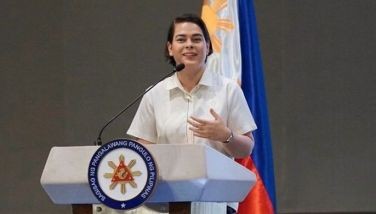Kaliwa

For over two decades now, we have been talking about the New Centennial Water Supply Project – more commonly known as the Kaliwa (Laiban) Dam project.
Without this new fresh water source, the Mega Manila area will continue to endure water supply shortages during the dry months. The metropolitan area is 98 percent dependent on water supplied from the ancient Angat Dam. That structure, and the small watershed around it, simply cannot deliver the water a booming metropolis needs.
It is not only that the population of the Mega Manila area continues to grow despite the congestion. Improving prosperity in the area also means that per capita water consumption will increase in the coming years. Water shortages will only become more severe unless a new water source is developed.
The only possible source of fresh water supply for the metropolitan area is the Kaliwa River in nearby Quezon Province. To obtain the fresh water that passes through this river draining into the Pacific Ocean, we have to build a dam (or a complex of water impounding structures) and then divert water flow toward the city.
This might sound simple enough. But the New Centennial Water Supply Project has been delayed for years by every imaginable problem: debate over the correct engineering solution to achieve the water diversion, the financing of the undertaking, the ecological soundness of the project and the potential dislocation of an indigenous community inhabiting the area to be flooded by the dam.
Had this project been completed according to its original schedule, which is two decades ago, we might have been spared the long bouts of water shortages that become all the more severe during El Nino years. With all the effects associated with climate change, the water shortage can only become more severe.
The good news is that China has offered official development assistance amounting to $211 million to see through the Kaliwa River project. But that represents only about 60 percent of total project costs, less if the costs inflate due to delays.
With this financing channel available, government abandoned the old public-private partnership format in favor of building the dam as a straight out public works endeavor. Continuing with the old format will probably delay this project by at least a decade more.
Accepting Chinese ODA, however, entails a Chinese company undertakes the project. The company will have to be chosen according to our own procurement rules. Those rules call for at least three qualified companies to participate in the bidding for the project.
This sets the stage for the bad news.
Irregular
The bidding was duly conducted. Three (Chinese) companies did participate. But the Commission on Audit (COA) does not find the bidding to be truly competitive, making the awarding of the contract irregular.
The COA sent its observations through an Audit Observation Memorandum (AOM) sent to the MWSS, the agency in charge of this project. In that AOM, the watchdog agency says state auditors “deduced that the two bidders/contractors were included merely to comply with the ‘at least three bidders requirement’ as stated under the Procurement Law.”
In more direct language, the state auditors are saying that the two losing bidders were brought in simply to create some semblance of competitive bidding. That was not the substance of the process by which the contract was eventually awarded.
The MWSS, it appears, did not give the AOM the attention it merits. It merrily went ahead with the project in contempt of the state auditors. That could turn out to be a costly mistake.
Recently, Manila Rep. Manny Lopez, chairman of the House committee on Metro Manila Development, called out the MWSS for trying to sweep under the rug what the COA deems to be an irregularity. He called on the water agency to properly address the serious procedural issues raised by the state auditors.
The COA observation could be a rallying point for a diverse range of interests critical of the project. These range from environmentalist groups and advocates for the indigenous communities, entities espousing an alternative engineering design for the project and corporations wanting a return to the old PPP format.
Unless the MWSS properly addresses the procedural issues raised by the state auditors, these issues could create a common ground for a diverse range of forces wanting the project scuttled. A project this large, this vital and this controversial requires great care on the part of the government agencies charged with executing it.
That care, apparently was not exercised.
Unless the procedural issues are cured, perhaps by way of rebidding the project, these issues could unleash political forces that could further delay or even destroy the entire undertaking. That is not an enticing prospect.
The dismissive attitude the MWSS has taken toward the audit observation amounts to a provocation. That will only magnify the concerns and allow an issue to be exploited by groups who are opposed to this project in any form.
Because it amounts to a provocation, it is irresponsible. It compromises the vital project or at least exposes it to unbearable delay while political forces come to play.
If enough agitation is enabled, the project might not happen. The metropolitan area will be vulnerable to long dry spells that will take a toll on our economic performance. People queuing up to pails of water will be as much a waste of productive time as people trapped in infernal traffic
That is the bad news.
- Latest
- Trending


























